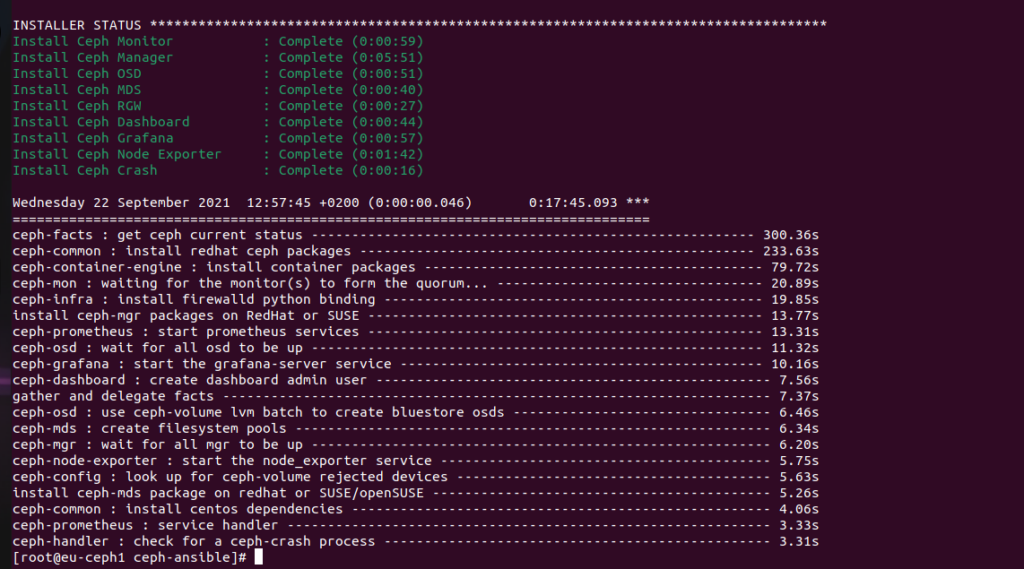I assume, that we have working Centos 8 Stream system. So, in this example, we will have three systems (nodes), with identical HW resources (4 GB ram, 4 vCPU, two NICs – one internal for ceph and one for world, and 10 TB spin-up hdd). In this article, every command must be run on all nodes. Public network is 192.168.1.0/24 and Ceph separate network is 192.168.2.0/24
Setting up time
As the first step, we must set up a time, I use chrony:
dnf install chrony -y systemctl enable chronyd timedatectl set-timezone Europe/Bratislava timedatectl
Now, edit some variables in configurations file for chronyd. Add some servers from pool, and edit local subnets, where we delived time:
vim /etc/chrony.conf pool 2.centos.pool.ntp.org iburst pool 1.centos.pool.ntp.org iburst pool 3.centos.pool.ntp.org iburst
Now start/restart our service, and check, if it is working:
systemctl restart chronyd systemctl status chronyd.service chronyc sources
Create hostnames, ssh rsa-keys, update and install som packages
Now, we must edit on all nodes our hostnames, set it permanent:
hostnamectl set-hostname ceph1
Now, add all hostnames, and IPs to file /etc/hosts:
tee -a /etc/hosts<<EOF 192.168.1.1 ceph1 192.168.1.2 ceph2 192.168.1.3 ceph3 192.168.2.1 ceph1-cluster 192.168.2.2 ceph2-cluster 192.168.3.3 ceph3-cluster EOF
Now, create rsa-key pair, for password-less connect to and from each node:
ssh-keygen -t rsa -b 4096 -C "ceph1" means: -b bits. Number of bits in the key to create -t type. Specify type of key to create -C comment
And copy it to other nodes:
for host in ceph1 ceph2 ceph3; do ssh-copy-id root@$host done
Now update and install packages:
dnf update -y -reboot- dnf install git vim bash-completion python3-pip
Preparing for ceph
Now, install epel repository and enable powertools:
dnf -y install dnf-plugins-core dnf -y install https://dl.fedoraproject.org/pub/epel/epel-release-latest-8.noarch.rpm dnf config-manager --set-enabled powertools dnf repolist repo id repo name appstream CentOS Stream 8 - AppStream epel Extra Packages for Enterprise Linux 8 - x86_64 epel-modular Extra Packages for Enterprise Linux Modular 8 - x86_64 epel-next Extra Packages for Enterprise Linux 8 - Next - x86_64 extras CentOS Stream 8 - Extras powertools CentOS Stream 8 - PowerTools
Clone Ceph Ansible repository:
cd /root/ git clone https://github.com/ceph/ceph-ansible.git
Choose ceph-ansible branch you wish to use. The command Syntax is: git checkout $branch
I’ll switch to stable-5.0 which supports Ceph octopus version.
cd ceph-ansible git checkout stable-5.0 pip3 install setuptools-rust pip3 install wheel export CRYPTOGRAPHY_DONT_BUILD_RUST=1 pip3 install --upgrade pip pip3 install -r requirements.txt echo "PATH=\$PATH:/usr/local/bin" >>~/.bashrc source ~/.bashrc
Confirm Ansible version installed.
ansible --version ansible 2.9.26 config file = /root/ceph-ansible/ansible.cfg configured module search path = ['/root/ceph-ansible/library'] ansible python module location = /usr/local/lib/python3.6/site-packages/ansible executable location = /usr/local/bin/ansible python version = 3.6.8 (default, Sep 10 2021, 09:13:53) [GCC 8.5.0 20210514 (Red Hat 8.5.0-3)]
Now, we find, which OSD (spin-up disks) are ready for us. In each my node, there is free disk /dev/sda. Look via lsblk:
lsblk NAME MAJ:MIN RM SIZE RO TYPE MOUNTPOINT sda 8:0 0 10.7T 0 disk sr0 11:0 1 1024M 0 rom vda 252:0 0 32G 0 disk ├─vda1 252:1 0 512M 0 part /boot └─vda2 252:2 0 31.5G 0 part ├─centos--vg0-root 253:0 0 3G 0 lvm / ├─centos--vg0-swap 253:1 0 1G 0 lvm [SWAP] ├─centos--vg0-tmp 253:2 0 512M 0 lvm /tmp ├─centos--vg0-var_log 253:3 0 512M 0 lvm /var/log ├─centos--vg0-var 253:4 0 3G 0 lvm /var └─centos--vg0-home 253:5 0 2G 0 lvm /home
Now, we are ready for installation of Ceph
Deploy Ceph Octopus (15) Cluster on CentOS 8 stream
Now, we are play some things 
cd /root/ceph-ansible cp group_vars/all.yml.sample group_vars/all.yml vim group_vars/all.yml
And edit some variables of your Ceph cluster, as you fit:
#General cluster: ceph # Inventory host group variables mon_group_name: mons osd_group_name: osds rgw_group_name: rgws mds_group_name: mdss nfs_group_name: nfss rbdmirror_group_name: rbdmirrors client_group_name: clients iscsi_gw_group_name: iscsigws mgr_group_name: mgrs rgwloadbalancer_group_name: rgwloadbalancers grafana_server_group_name: grafana-server # Firewalld / NTP configure_firewall: True ntp_service_enabled: true ntp_daemon_type: chronyd # Ceph packages ceph_origin: repository ceph_repository: community ceph_repository_type: cdn ceph_stable_release: octopus # Interface options monitor_interface: ens18 radosgw_interface: ens18 public_network: 192.168.1.0/24 cluster_network: 192.168.2.0/24 # DASHBOARD dashboard_enabled: True dashboard_protocol: http dashboard_admin_user: admin dashboard_admin_password: strongpass grafana_admin_user: admin grafana_admin_password: strongpass
Now, set your OSDs. Create a new ceph nodes ansible inventory. Properly set your inventory file. Below is my inventory. Modify inventory groups the way you want services installed in your cluster nodes.
vim hosts # Ceph admin user for SSH and Sudo [all:vars] ansible_ssh_user=root ansible_become=true ansible_become_method=sudo ansible_become_user=root # Ceph Monitor Nodes [mons] ceph1 ceph2 ceph3 # MDS Nodes [mdss] ceph1 ceph2 ceph3 # RGW [rgws] ceph1 ceph2 ceph3 # Manager Daemon Nodes [mgrs] ceph1 ceph2 ceph3 # set OSD (Object Storage Daemon) Node [osds] ceph1 ceph2 ceph3 # Grafana server [grafana-server] ceph1
Create Playbook file by copying a sample playbook at the root of the ceph-ansible project called site.yml.sample.
cp site.yml.sample site.yml
Run Playbook.
ansible-playbook -i hosts site.yml
If installation was successful, a health check should return OK or minimal WARN.
# ceph -s
cluster:
id: dcfd26f5-49e9-4256-86c2-a5a0deac7b54
health: HEALTH_WARN
mons are allowing insecure global_id reclaim
services:
mon: 3 daemons, quorum eu-ceph1,eu-ceph2,eu-ceph3 (age 67m)
mgr: ceph2(active, since 55m), standbys: ceph3, ceph1
mds: cephfs:1 {0=ceph1=up:active} 2 up:standby
osd: 3 osds: 3 up (since 60m), 3 in (since 60m)
rgw: 3 daemons active (ceph1.rgw0, ceph2.rgw0, ceph3.rgw0)
task status:
data:
pools: 7 pools, 169 pgs
objects: 215 objects, 11 KiB
usage: 3.1 GiB used, 32 TiB / 32 TiB avail
pgs: 169 active+clean
This is a screenshot of my installation output once it has been completed.

As you see, I have warning: mons are allowing insecure global_id reclaim
So, silent it, as you fit it, or fix…
ceph config set mon mon_warn_on_insecure_global_id_reclaim_allowed false